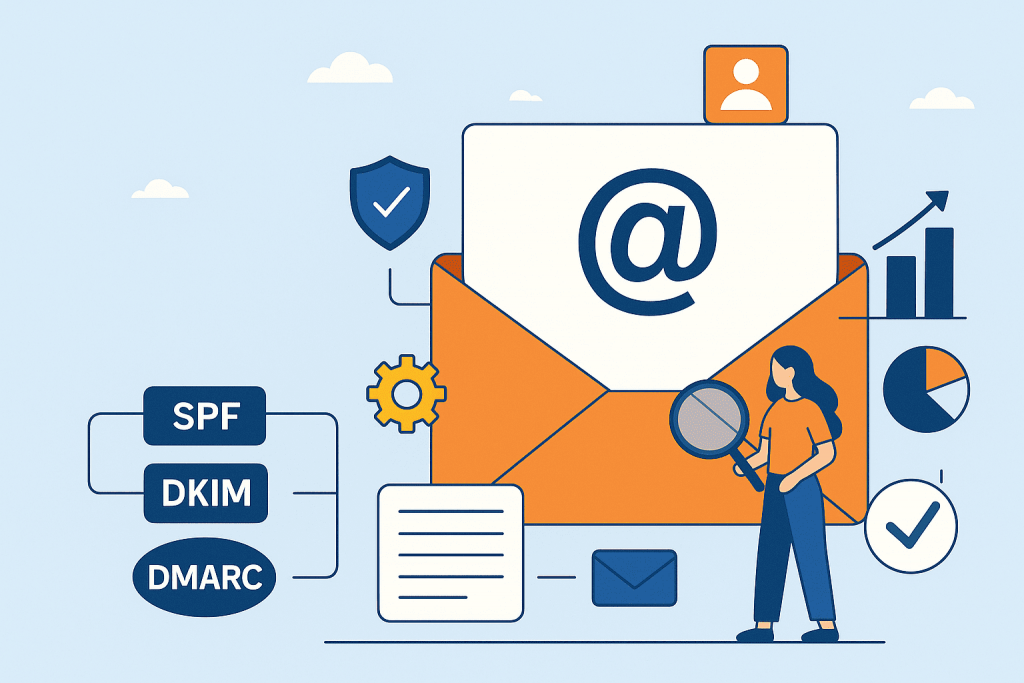
Email marketing remains one of the most effective communication channels for businesses. It helps not only to promote products and services but also to build long-term relationships with clients, increase loyalty, and drive users back to your website. However, high efficiency is only achievable through proper technical setup and strategic planning. In this article, we’ll dive deep into how to optimize your email campaigns — from essential authentication settings to advanced performance analytics.
1. SPF, DKIM, and DMARC: The Foundation of Deliverability and Trust
To ensure your emails reach inboxes and don’t end up in the spam folder, you must prove that you have the right to send emails on behalf of your domain.
- SPF (Sender Policy Framework) — a DNS record that lets mail servers verify whether a given server is authorized to send emails from your domain. If you’re using third-party services like Mailchimp, Sendinblue, or your own SMTP server on a VPS, be sure to add the relevant IP addresses to your SPF record.
- DKIM (DomainKeys Identified Mail) — provides a cryptographic signature for each email. It helps the recipient’s server verify that the email hasn’t been tampered with and was sent from your domain. This is especially important for corporate communication.
- DMARC (Domain-based Message Authentication, Reporting & Conformance) — brings SPF and DKIM together into one unified policy. It tells mail services how to handle messages that fail authentication: accept, quarantine, or reject them. It also enables reporting, helping you detect abuse attempts and spoofing.
If you’re managing your mail infrastructure manually, we recommend renting a VPS, which gives you full root access and the flexibility to configure all of these systems properly. A dedicated environment is essential for reliable large-scale email marketing.
2. PTR Records and IP Reputation: Crucial for Inbox Placement
Even with proper SPF, DKIM, and DMARC settings, poor IP reputation can block your emails. Your sender IP’s trustworthiness is determined by factors such as complaint rates, bounce rates, and email volume patterns.
PTR (reverse DNS record) — links your server’s IP address to your domain. Many mail servers will not accept messages from servers without a proper PTR record, or they will classify them as suspicious. Most reliable hosting providers let you configure PTR manually or via support.
It’s also important to regularly check your IP address against blacklists (like Spamhaus, SORBS, Barracuda) using tools such as mxtoolbox.com. If your IP is listed, your deliverability will drop drastically.
For best results, use dedicated infrastructure — such as server colocation or a dedicated server in a secure data center, or a VPS with a unique IP address.
3. How Email Content Affects Deliverability and Conversions
Technical compliance is just one piece of the puzzle. The next step is crafting content that encourages users to open the email, read it, and click your links.
- Subject line — the first thing your recipients see. It should be short, clear, and intriguing. For example: “5 reasons your site is slow” or “Get 3 months of SSL — free.”
- Personalization — if your platform allows it, address recipients by name and tailor the content to their interests. This can boost open rates by 20–30%.
- Design — use responsive layouts with at least 60% text and no more than 40% images. Avoid image-only emails — they’re likely to be flagged as spam.
- Unsubscribe link — make it clearly visible. It’s not just a legal requirement but also builds trust. Users should feel in control of their inbox.
4. BIMI: Brand Visibility Before the Email Is Opened
BIMI (Brand Indicators for Message Identification) is a new standard that allows your brand’s logo to appear next to your emails in the recipient’s inbox. This only works if DMARC is properly configured and a Verified Mark Certificate (VMC) is obtained.
BIMI helps reinforce your brand identity and increases click-through rates significantly — sometimes by 10–20%.
However, implementing BIMI is a technically demanding process: it requires an SVG logo in a specific format, properly configured DNS entries, and certificate approval from an authorized provider.
The cost of a VMC certificate ranges from $400 to $1,000 per year. While it may seem high, it’s a worthwhile investment for businesses with large subscriber lists.
5. Email Analytics: The Numbers That Really Matter
No email campaign should be launched without proper tracking and analysis. Consistent performance monitoring helps you:
- Understand which subject lines drive the most opens.
- Identify the most effective times and days to send.
- Clean inactive or invalid email addresses from your list.
Key metrics to monitor:
- Open Rate — the percentage of recipients who open your email. Indicates subject line effectiveness and sender reputation.
- Click-Through Rate (CTR) — percentage of users who click on links. Reflects how compelling your content is.
- Conversion Rate — how many recipients completed a desired action (purchase, registration).
- Bounce Rate — percentage of emails that weren’t delivered.
- Unsubscribe Rate — how many people opted out.
Most platforms — such as MailerLite, SendGrid, or even your custom SMTP setup — support integration with Google Analytics, allowing you to track user behavior beyond the email itself.
6. Automation, Segmentation, A/B Testing
Don’t send the same content to your entire list. Smart email marketing is about sending the right message to the right person at the right time. For that, you’ll need:
- Segmentation — group your audience by interests, behavior, and purchase history.
- Triggers — automated email flows based on actions (welcome series, cart abandonment, order confirmations).
- A/B testing — test different subject lines, layouts, CTAs to identify what performs best — based on real data.
Conclusion
Effective email marketing is a mix of technical integrity, relevant content, and data-driven optimization. To make sure your emails land in inboxes and drive real results, you must:
- Configure SPF, DKIM, DMARC, and PTR records properly.
- Choose a reliable server or VPS with a dedicated IP.
- Create personalized, mobile-friendly content.
- Measure performance and adjust your strategy accordingly.
Email marketing is more than a sales tool — it’s a reflection of your brand. And how well you manage it directly affects your reputation, user trust, and business growth.
Ready to take your email campaigns to the next level? Start by building a solid foundation: secure your domain, configure your infrastructure, automate smartly — and turn every email into a high-impact touchpoint.

Leave a Reply